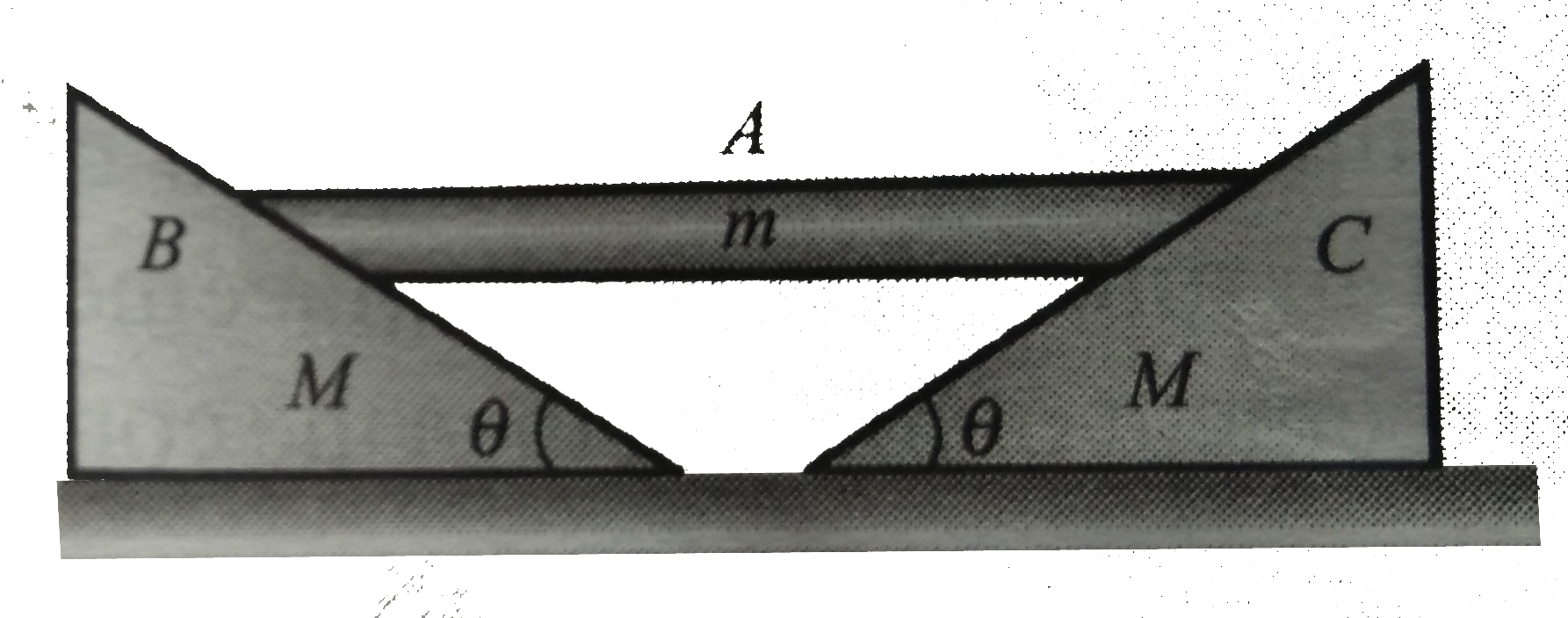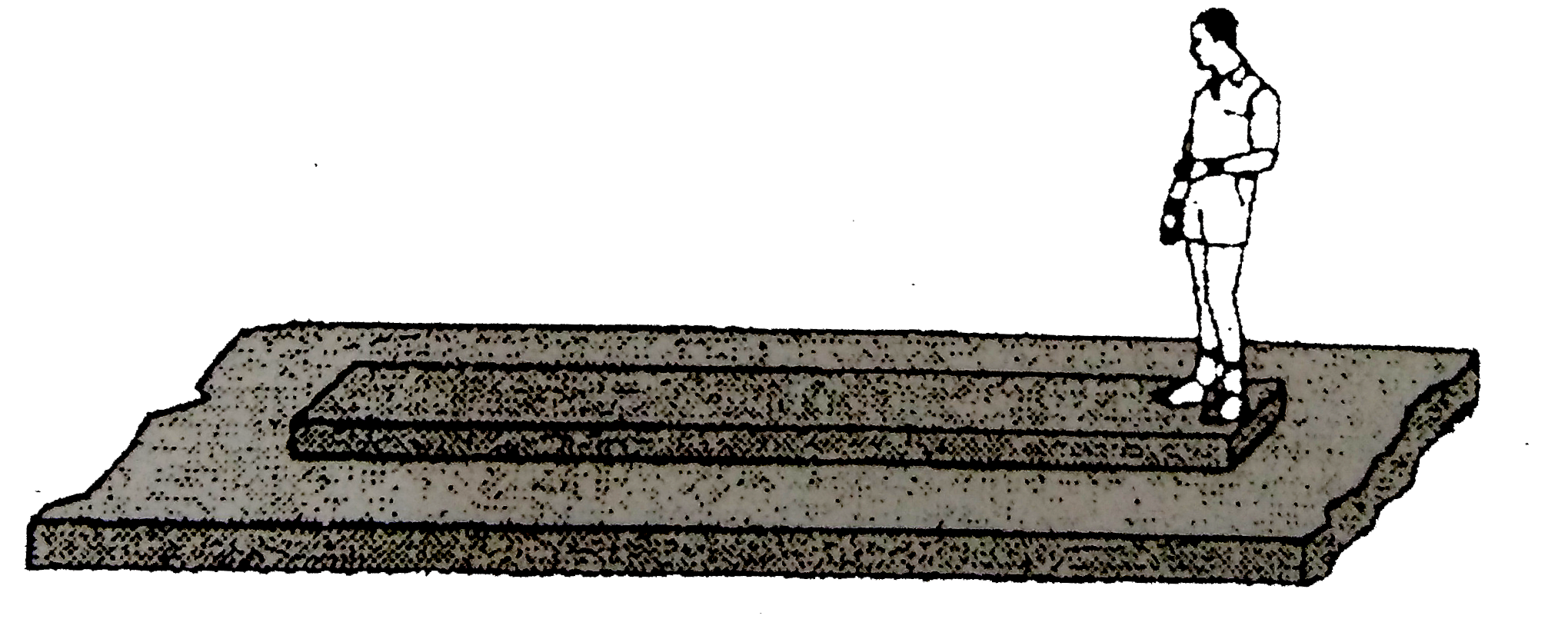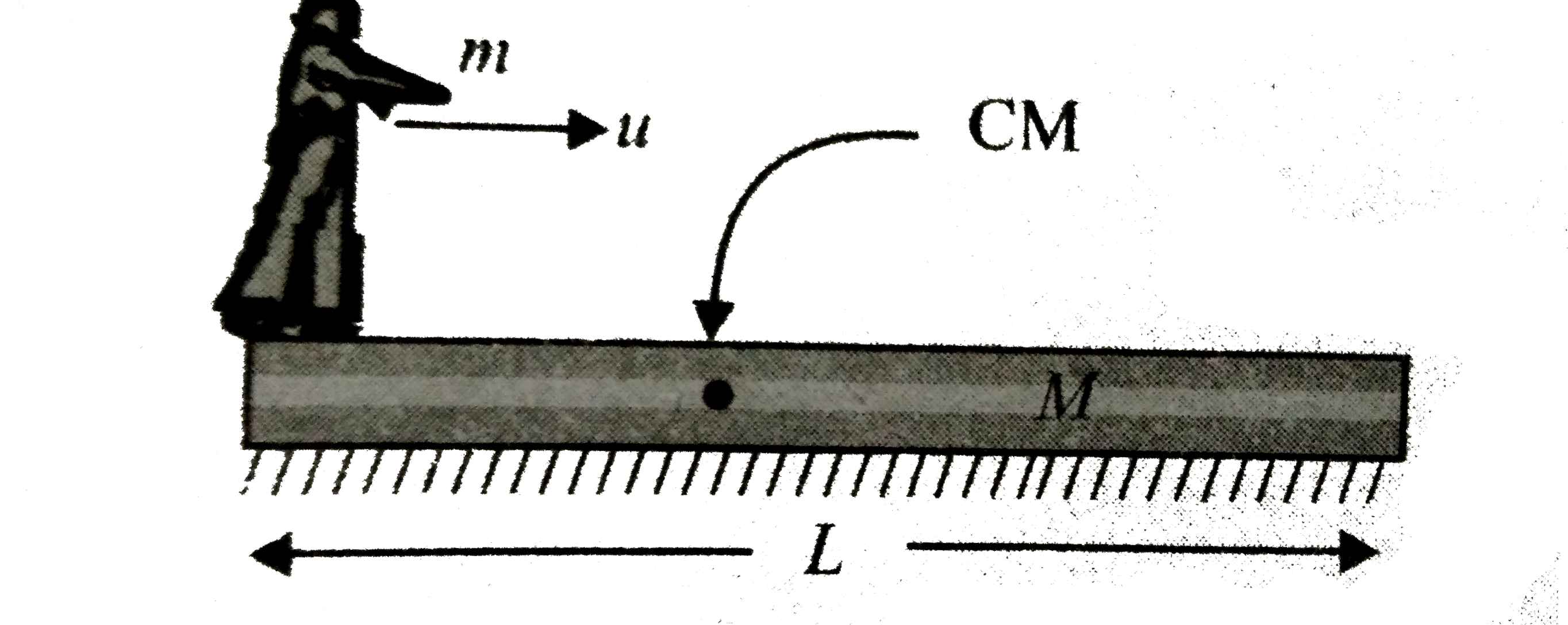Two planks each of mass m and length L are connected by a friction less mass less hinge as shown in the figure. Initially the system is at rest on a level friction less surface. The vertical plank falls anticlockwise and finally comes to rest on the top of the horizontal plank.Find the displacement of the hinge till the two planks come in contact.
In horizontal direction centre of mass does not move.
Related Solutions
A plank of mass m rests symmetrically on two wedges B and C of mass M. What is the acceleration of the plank? Neglect friction between all the contact surfaces.
 View Solution
View SolutionA plank of mass m rests symmetrically on two wedges B and C of mass M. What is the acceleration of the plank? Neglect friction between all the contact surfaces.
 View Solution
View SolutionA uniform disc of mass M and radius R initially stands vertically on the right end of a horizontal plank of mass M and length L, as shown,

The plank rests on a smooth horizontal floor and friction between disc and plank is sufficiently high such that disc rolls on plank without slipping . The plank is pulled to right with a constant horizontal force of magnitude F.
The distance travelled by centre of disc from its initial position till the left end of plank comes vertically below the centre of disc isView SolutionA uniform disc of mass M and radius R initially stands vertically on the right end of a horizontal plank of mass M and length L, as shown,

The plank rests on a smooth horizontal floor and friction between disc and plank is sufficiently high such that disc rolls on plank without slipping . The plank is pulled to right with a constant horizontal force of magnitude F.
The distance travelled by centre of disc from its initial position till the left end of plank comes vertically below the centre of disc isView SolutionA man of mass m is moving with a constant acceleration a w.r.t plank is .The plank less on a smooth horizontal floor If the mass of plank m then calculate the acceleration of plank and man w.r.t ground and frictional force extended by plank on man
View SolutionA man of mass m is moving with a constant acceleration a w.r.t plank is .The plank less on a smooth horizontal floor If the mass of plank m then calculate the acceleration of plank and man w.r.t ground and frictional force extended by plank on man
View SolutionA plank of mass m moving with a velocity v along a friction less horizontal track and a body of mass m//2 moving with 2v collides with plank elastically. Final speed of the plank is:
View SolutionA man of mass m is standing at one end of of a plank of mass M. The length of the plank is L and it rests on a frictionless horizontal ground. The man walks to the other end of the plank. Find displacement of the plank and man relative to the ground.
 View Solution
View SolutionA man of mass m moves on a plank of mass M with a constant velocity u with respect to the plank, as shown in figure. a.If the plank rests on smooth horizontal surface, determine the velocity of the plank. .
View SolutionA block of mass is horizontally thrown with a velocity of on a statonary long plank of mass whose surface has plank rest on friction surface find the time when the block comes to rest w.r.t plank
 View Solution
View SolutionA man of mass m moves on a plank of mass M with a constant veloicty u with respect to the plank, as shown in figure. a.If the plank rest on smooth horizontal surface, determine the velocity of the plank. b If the man travels a distasnce L with respect to the plank, find the distance travelled by the plank with respect to te ground.
View SolutionA man of mass moves on a plank of mass with a constant veloicty with respect to the plank, as shown in figure.
a.If the plank rest on smooth horizontal surface, determine the velocity of the plank.
b If the man travels a distasnce with respect to the plank, find the distance travelled by the plank with respect to te ground. View Solution
View SolutionA uniform disc of mass M and radius R initially stands vertically on the right end of a horizontal plank of mass M and length L, as shown,

The plank rests on a smooth horizontal floor and friction between disc and plank is sufficiently high such that disc rolls on plank without slipping . The plank is pulled to right with a constant horizontal force of magnitude F.
The magnitude of acceleration of plank is
F/ 6 M
F/ 4 M
3 F/ 2 M
3 F/ 4 MView SolutionA man of mass M stands at one end of a plank of length L which is at rest on a frictionless horizontal surface. The man walks to the other end of the plank. If mass of the plank is M/3, the distance that the man moves relative to ground is
View SolutionA man of mass M stands at one end of a plank of length L which is at rest on a frictionless horizontal surface. The man walks to the other end of the plank. If mass of the plank is M/3, the distance that the man moves relative to ground is
View SolutionA plank of mass M and length L is at rest on a frictionless floor. At one end of it a child of mass m is standing as shown in figure-4.41. If child walks towards the other end, find the distance, which the plank moves (a) till the child reaches the centre of the plank, (b) till the child reaches the other end of the plank.
View SolutionChoose the correct option: A sphere of mass m is given some angular velocity about a horizontal axis through its centre and gently placed on a plank of mass 'm'. The co-efficient of friction between the two is mu . The plank rests on a smooth horizontal surface. The initial acceleration of the centre of sphere relative to the plank will be
View SolutionA sphere of mass m is given some angular velocity about a horizontal axis through its centre and gently placed on a plank of mass 'm'. The co-efficent of friction between the two is mu . The plank rests on a smooth horizontal surface. The initial acceleration of the centre of sphere relative to the plank will be
View SolutionNo external force: Stationery mass relative to an inertial frame remains at rest
A man of mass m is standing at one end of of a plank of mass M. The length of the plank is L and it rests on a frictionless horizontal ground. The man walks to the other end of the plank. Find displacement of the plank and man relative to the ground.
 View Solution
View SolutionNo external force: Stationery mass relative to an inertial frame remains at rest
A man of mass m is standing at one end of of a plank of mass M. The length of the plank is L and it rests on a frictionless horizontal ground. The man walks to the other end of the plank. Find displacement of the plank and man relative to the ground.
 View Solution
View Solution
